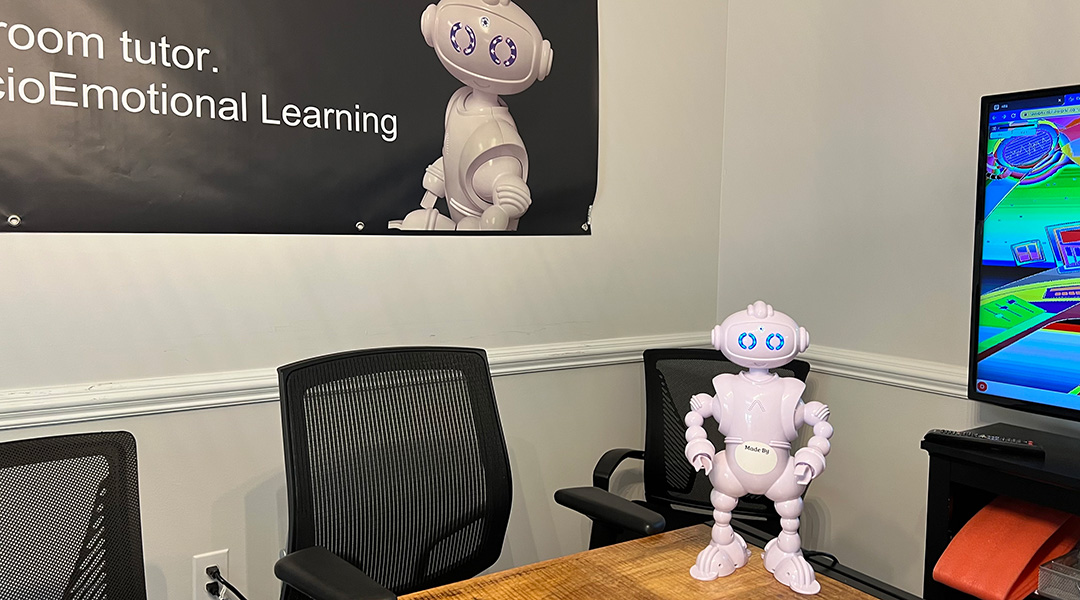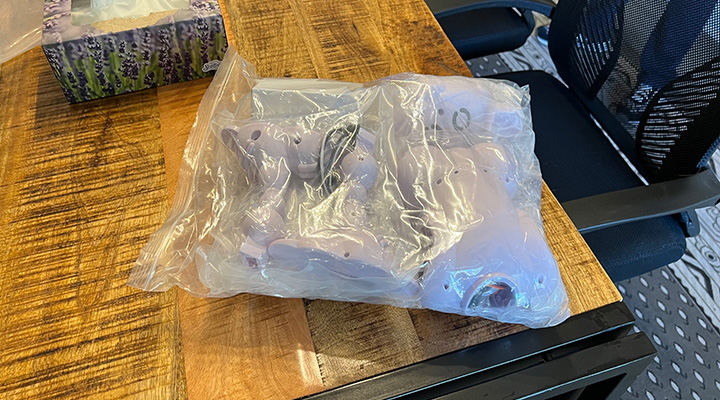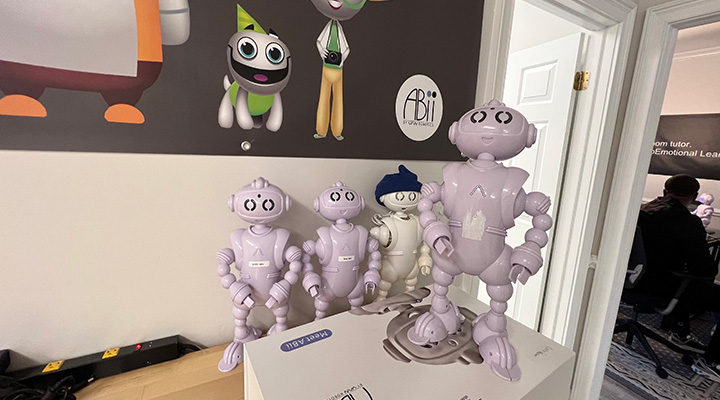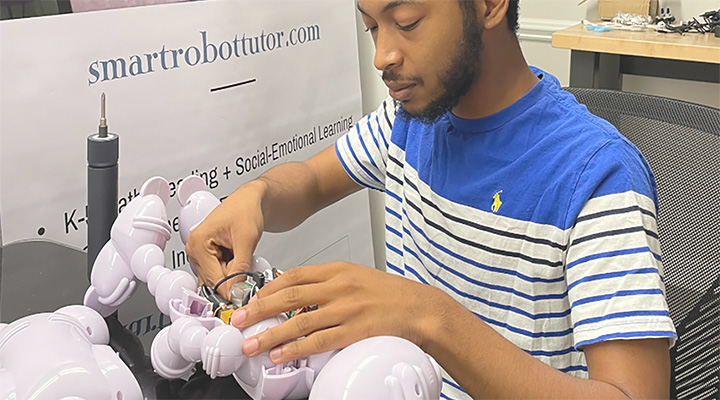An ABii robot powers up, showing off lights and animation. (Photo by Stephen Pastis)
Two years ago, Van Robotics, a multi-million dollar Columbia robotics company, realized high school students could be a solution to its manufacturing issues.
The company was looking for a way around the complications and delays that came from manufacturing its product in China. So a conversation started about how to have school districts buy the building kits, then have the students build the robots from parts shipped from China. The robots then are delivered to younger students to be used as electronic tutors when they’re doing independent work.
Bringing high school students into the manufacturing process gives students work experience and helps increase diversity in STEM studies, the company said.
“This idea started a while ago, but all the pieces and components all the people, the right people, are kind of working on this collaboratively to make it something really, really different,” said Laura Boccanfuso, the CEO of Van Robotics.
Today, the idea has become Van Robotic’s Classroom to Career program, a 9-week curriculum organized with schools in which teachers and high school students learn to build the ABii robot from a provided kit. Classroom to Career is establishing a pilot program through a research grant in three districts — Rock Hill, Sumter, Barnwell counties, Boccanfuso said.
While the parts are still manufactured in China, the assembly will be performed by the high school students. Then, the high school students hand-deliver the robots to the younger students, typically in fourth and fifth grades.
The program ideally will create a peer ecosystem, with the older kids becoming role models and an inspiration for the younger students, Boccanfuso said.
While the project is still in early development and testing, the company hopes the project someday will be a larger part of its larger product lineup. For schools, it doesn’t hurt that the program helps increase diversity and participation in STEM, Boccanfuso said.
The company has attempted other methods of expediting the manufacturing process, such as internships with University of South Carolina engineering students. But the Classroom to Career program solved another recurring issue — high school students’ interest in participating.
“We took that kernel of an idea, and then we said, ‘Well, what are we, who do we really want to reach with this?’” Boccanfuso said.
In building the curriculum, Boccanfuso said the company wanted to have the program be more than just skills-based.
“We said, ‘No, we want this to be an opportunity for us to improve inclusion and equity across groups of students who didn’t ever think of themselves as a STEM student,’” Boccanfuso said. “And so that’s how it started to really gain momentum.”
Seeing the high school students’ hands-on work allows the younger students perhaps to change their personal beliefs about a STEM career track.
“I think that’s so poignant, because after COVID, I think most people crave that human to human connection,” Boccanfuso said. “So when girls or like underrepresented minorities see there’s an application to work with people through technology — this could be a connection piece.”
THE ROBOT
The ABii is a quirky, robot tutor that plugs into a student’s computer. It uses encouraging words and one-man “dance parties” — as well as artificial intelligence and cameras — to make sure the student is engaged and to help teach younger students a curriculum or lesson set from a teacher.
The schools involved in the pilot program will receive their ABii kits through a research grant. The program costs $1,650 for schools, including curriculum, per student.
Van Robotics has been on the market for just more than two years. Today, its robots are in 38 states across the United States and eight countries.
Boccanfuso said this is proof of the company’s success. The high customer return rate is further evidence. Schools regularly come back to purchase more, she said.
As for the new program, the parental consent forms are “rolling in,” Boccanfuso said.
Carolina Boccanfuso, the director of marketing and strategy, said she was at a trade show recently in Myrtle Beach when a teacher from Sumter came up to her.
“She stood there and talked to me for like 20 minutes about how excited her and her students were about it,” Carolina Boccanfuso said.
TESTING IT OUT
Franklin McCormack, principal at Barnwell High School, said he has seen a number of educational trends go through the high school. He doesn’t think this will be one of them.
“With what they’re trying to do with the exposure, that is unlike anything we’ve ever done,” McCormack said. “We’ve never done anything like that. It’s intriguing and it’s just a different angle.”
Barnwell County is large in size, but sparse in population. Its schools are small and rural, McCormack said. The number of kids who go on to STEM based careers is small, not to mention the lack of diversity, he said.
“We are just trying to break that cycle so that kids know you can do anything you want to do,” he said. “It doesn’t matter what your background is, what your gender is.”
But that’s something different that McCormack hopes the program will change. Even though it took some convincing for students, those who weren’t swayed by the science element were convinced by receiving community service hours for their programs, he said.
McCormack sees it as worth the price, too, he said.
“Regardless, whatever the motivation that initially got them from a recruiting standpoint, I think in the end, they’re going to realize that the importance of it,” McCormack said. “But they won’t realize it until later on down the road.”





